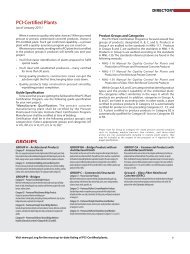Winning Without Competition: How to Break Out of a Commodity ...
Winning Without Competition: How to Break Out of a Commodity ...
Winning Without Competition: How to Break Out of a Commodity ...
You also want an ePaper? Increase the reach of your titles
YUMPU automatically turns print PDFs into web optimized ePapers that Google loves.
• They are linked horizontally and vertically.<br />
• They can be diagrammed in terms <strong>of</strong> their interaction with other parts <strong>of</strong> the<br />
organization.<br />
• They can be measured—although not always easily measured.<br />
• They can be improved.<br />
• They have a major impact on differentiation <strong>of</strong> the firm, cus<strong>to</strong>mer value,<br />
return on assets and organizational goals.<br />
The first step in process improvement is <strong>to</strong> identify the macro processes <strong>of</strong> the<br />
organization (Chart One: Macro Process View <strong>of</strong> a Precast Company gives an<br />
example). One approach <strong>to</strong> selecting critical processes from this list is <strong>to</strong><br />
categorize each macro process in<strong>to</strong> one <strong>of</strong> the following categories <strong>of</strong> importance:<br />
• Identity: It serves a major role in creating the desired differentiation <strong>of</strong> your<br />
company.<br />
• Priority: It meets a cus<strong>to</strong>mer requirement and strongly influences how well<br />
identity processes are carried out and how the firm stands versus the<br />
competition.<br />
• Background: It supports other processes; many management processes fall<br />
here.<br />
• Mandated: It is required by, for example, government <strong>of</strong>ficials.<br />
• Folklore: These are processes that have been in place in the past, but are not<br />
necessarily needed <strong>to</strong>day.<br />
Chart Two: Example <strong>of</strong> the Process Salience <strong>of</strong> Different PC-PS Companies shows<br />
an example <strong>of</strong> process categorization for two precast firms, each with very<br />
different competitive strategies. (For more information on this <strong>to</strong>pic, see Keen,<br />
whose work guided the thoughts in this section.)<br />
Identity and priority processes, or those that could be identity and priority<br />
processes, become the strategic processes for the organization. Organizations<br />
should focus improvement and redesign efforts on background processes only if<br />
they are becoming, or could become, a priority process. Mandated processes take<br />
on strategic important if changing them has a major positive impact on the<br />
pr<strong>of</strong>itability <strong>of</strong> the firm. In general, background processes do not pass this test.<br />
Any folklore process should be removed.<br />
After categorizing processes, the organization must select which critical processes<br />
it wants <strong>to</strong> improve or redesign so as <strong>to</strong> achieve greater success. The key <strong>to</strong> doing<br />
this is <strong>to</strong> determine which critical processes <strong>of</strong> the organization already perform<br />
above average versus which perform at or below average. Because <strong>of</strong> limited<br />
resources, the organization may choose <strong>to</strong> moni<strong>to</strong>r performance <strong>of</strong> critical<br />
processes with above average performance in order <strong>to</strong> maintain a lead. Any<br />
critical processes that are at or below the performance <strong>of</strong> other competi<strong>to</strong>rs, i.e.,<br />
that are not best in class, must be improved or redesigned.<br />
Pamphlet #5 Page 190







